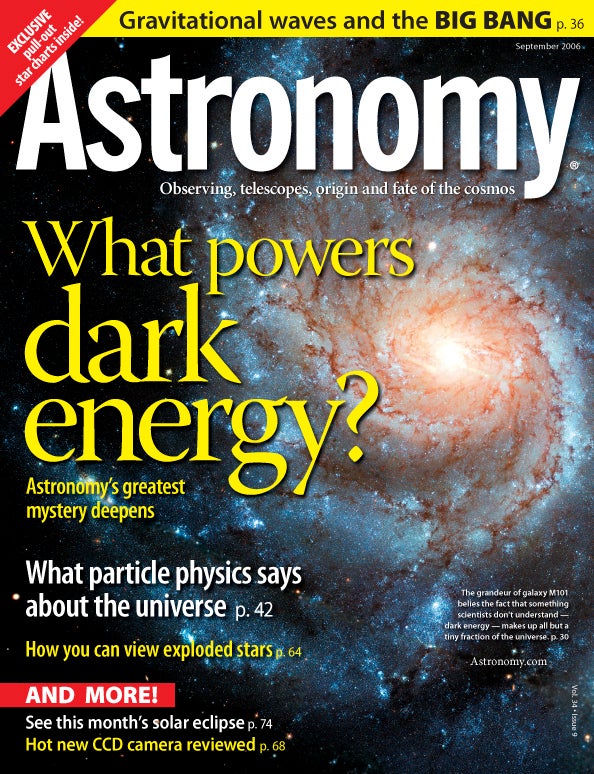
The September 2006 Astronomy magazine provides a special report on the latest discoveries in cosmology. The issue appears on newsstands August 1. Credit: NASA/ESA.
Astronomy‘s mission
Astronomy promotes the science and hobby of astronomy through high-quality publications that engage, inform, entertain, and inspire.
For more information, contact:
Matt Quandt
Public Relations Specialist
[t] 262.796.8776 x419
[e] mquandt@kalmbach.com
July 25, 2006
Matt Quandt
Public Relations Specialist
[t] 262.796.8776 x419
[e] mquandt@kalmbach.com
July 25, 2006
Astronomy offers publication-quality images below.
More Astronomy resources:
Astronomy news
This week’s sky events
Astronomy basics
Glossary of astronomical terms
Return to Astronomy “For the media” page
To set up an interview, please contact Matt Quandt: 262.796.8776 x419, mquandt@kalmbach.com.
Shedding light on dark energy
“Tales from the dark side,” by Astronomy contributing editor Steve Nadis, puts dark energy under the spotlight. This ubiquitous entity makes up about 75 percent of the universe and fuels the universe’s accelerating expansion. Yet despite its prevalence and power, dark energy remains a mystery to scientists. Learning about this force will redefine our knowledge of the cosmos.
“Dark energy is not predicted by the physics we understand,” says Adam Reiss of the Space Telescope Science Institute in Baltimore. “So learning about it will almost certainly lead us to something new and exotic.”
Nadis’ article includes a rundown on future projects to detect dark energy, as well as detailed illustrations outlining the four methods to target dark energy.
Listen to echoes from the Big Bang
“A wrinkle in space time,” by University of Rochester astrophysicist Adam Frank delves into new developments in Big Bang science. Peering into the Big Bang’s earliest moments is every cosmologist’s dream. Detecting gravitational waves set in motion by the great event will make it a reality.
Frank writes, “Forty-two years ago, astronomers first heard the Big Bang’s echoes. The cosmic microwave background, or CMB, is relic radiation from the universe’s birth, a fossil formed 380,000 years after the Big Bang. Recognition of the CMB marked the beginning of modern cosmology, and it’s still telling astronomers much about the early universe.”
Big science from the smallest particles
In “The universe is in the details,” University of Chicago assistant professor of physics Scott Wakely explores how the smallest particles at the highest energies may hold answers to questions about the universe’s most energetic phenomena. Adding another piece to the Big Bang puzzle, Wakely describes how particle astrophysics links the tiny with the immense to study the universe’s earliest moments.
How fast does the Sun travel through space?
While a speeding bullet is no match for Superman, the Krypton superhero would be hard-pressed to match the speed of most objects in space. In this two-page super-graphic, Astronomy compares the speeds of planets, comets, the Sun, galaxies, and even the universe. For example:
Eclipse of the Sun in September
Astronomy contributing editor Martin Ratcliffe previews the September 22 annular eclipse of the Sun, which will occur over the mid-Atlantic and South America. The article includes a global map of the eclipse’s path, as well as a close-up map that plots the South American cities lucky enough to witness the great ring of fire.
Also in the issue
The September 2006 Astronomy also includes Ask Astro, Astro news, Bob Berman’s strange universe, Glenn Chaple’s observing basics, Phil Harrington’s binocular universe, The sky this month, New products, and Reader gallery.









